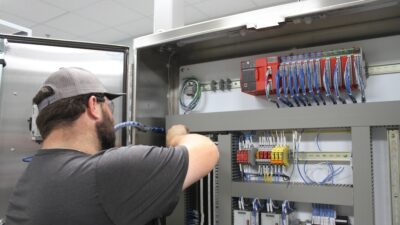Engineers from Control Corp. of America (Richmond, Va.) completed the first large-scale automation of a U.S. Navy aircraft carrier using commercial-off-the-shelf (COTS) automation equipment. Automation provides state-of-the-art control for the management of jet fuel on the carrier. Using commercial equipment reduces the cost of construction, personnel requirements to operate the ship, an...
Engineers from Control Corp. of America (Richmond, Va.) completed the first large-scale automation of a U.S. Navy aircraft carrier using commercial-off-the-shelf (COTS) automation equipment. Automation provides state-of-the-art control for the management of jet fuel on the carrier. Using commercial equipment reduces the cost of construction, personnel requirements to operate the ship, and repair time, while improving system fault detection time, and providing enhanced logistics support.
Welcome aboard the United States Ship Harry S. Truman (CVN75), Nimitz class nuclear-powered aircraft carrier.
Its deck is nearly 1,100 ft long and over 250 ft wide. Fully loaded, it displaces over 100,000 tons and moves this mass at over 30 knots, though actual speed is classified. The ship can remain at sea for over 10 years, carrying more than three million gallons of fuel along with over 100 of the world’s most advanced planes and top pilots to fly them.
The primary function of an aircraft carrier is to launch and recover warplanes, as part of its assigned defense missions. Fuel must be available at the flight deck service tanks at all times.
Despite the crucial nature and complexity of systems on its advanced ships, the Navy wanted to move away from proprietary, one-of-a-kind control systems in favor of COTS products.
However, COTS hardware cannot just be purchased and installed. Other than prototype installations, all hardware is required to meet the same specifications and tests as the traditional military hardware it replaces.
Behind the automation effort was a five-year journey of discussion, design reports, product selection testing, application software development testing, hardware construction, ship installation testing, and sea trials.
A conservative approach was used to automate the Truman’s two fuel management systems, located forward and aft. The aft configuration was completed first, with installation and testing performed at anchor, followed by testing at sea during flight operations. After completing this test and making minor modifications, added testing was done during an at-sea replenishment operation. Once this operation was completed, the forward fuel system was installed.
Those associated with the project selected Siemens Energy & Automation’s (Alpharetta, Ga.) S7-416 PLCs, primarily for their capability in networking, performance, redundancy options, and open protocols. These controllers operate in a “warm-backup” mode, reading and writing the I/O points simultaneously through Siemens’ redundant ET200M I/O interface modules.
Communication between the controllers and the I/O points is Profibus-DP at 1.5 Mb/sec. Profibus was chosen for its speed, large assortment of available products, and status as an international standard. The CNV75 project mainly uses Siemens I/O devices, but other applications on these ships have I/O products from several other vendors.
Survivability
For system survivability, the I/O devices and controller connections are achieved using Siemens Optical Link Modules—which support a dual fiber-optic ring. In case of a break in the communication path, the data travel around the ring in the opposite direction still maintaining a communication path. In case of multiple communication breaks, the controllers maintain the ability to communicate in both directions, and function with the remaining I/O points. The controllers are located in strategically separate areas.
Network communications are managed using commercially available Ethernet switches/hubs. These devices communicate via multiple fiber-optic communication paths for survivability.
The primary job of the fuel management system is monitoring tank levels, commanding and interlocking valves, monitoring for presence of seawater, alarming tank overflow conditions, and monitoring purifiers and other equipment.
System performance with the application has been excellent. Each scan, both forward and aft, executes logic for all devices, all tank table lookup functions, redundancy code, detailed system diagnostics, and synchronizes device data between controllers in approximately 110 msec. The HMI screen updates occur in one to two seconds.
Tests and trials show that COTS equipment can meet operational needs of many military applications.



